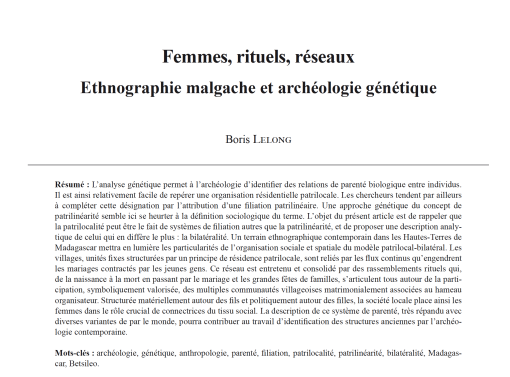Prix : 15,00 €TTC
06-2025, tome 122, 2, p. 191-202 - Lelong B. - Femmes, rituels, réseaux : ethnographie malgache et archéologie génétique
Femmes, rituels, réseaux
Ethnographie malgache et archéologie génétique
Boris Lelong
Résumé :
L’analyse génétique permet à l’archéologie d’identifier des relations de parenté biologique entre individus. Il est ainsi relativement facile de repérer une organisation résidentielle patrilocale. Les chercheurs tendent par ailleurs à compléter cette désignation par l’attribution d’une filiation patrilinéaire. Une approche génétique du concept de patrilinéarité semble ici se heurter à la définition sociologique du terme. L’objet du présent article est de rappeler que la patrilocalité peut être le fait de systèmes de filiation autres que la patrilinéarité, et de proposer une description analytique de celui qui en diffère le plus : la bilatéralité. Un terrain ethnographique contemporain dans les Hautes-Terres de Madagascar mettra en lumière les particularités de l’organisation sociale et spatiale du modèle patrilocal-bilatéral. Les villages, unités fixes structurées par un principe de résidence patrilocale, sont reliés par les flux continus qu’engendrent les mariages contractés par les jeunes gens. Ce réseau est entretenu et consolidé par des rassemblements rituels qui, de la naissance à la mort en passant par le mariage et les grandes fêtes de familles, s’articulent tous autour de la participation, symboliquement valorisée, des multiples communautés villageoises matrimonialement associées au hameau organisateur. Structurée matériellement autour des fils et politiquement autour des filles, la société locale place ainsi les femmes dans le rôle crucial de connectrices du tissu social. La description de ce système de parenté, très répandu avec diverses variantes de par le monde, pourra contribuer au travail d’identification des structures anciennes par l’archéologie contemporaine.
Mots-clés : archéologie, génétique, anthropologie, parenté, filiation, patrilocalité, patrilinéarité, bilatéralité, Madagas-car, Betsileo.
Abstract:
Genetic analysis enables archaeologists to identify biological kinship relationships between individuals. It is thus relatively easy to identify a patrilocal residential organization (men live in their birth village, while women move to their husband’s). Researchers tend to complement this designation with the attribution of a patrilineal descent structure. However, patrilocality and patrilinearity are two different principles, and the former does not necessarily lead to the latter. Here, a genetic approach to the concept of patrilineality seems to clash with the sociological defini-tion of the term. As understood by anthropologists, patrilineality is a way of organizing social relationships that builds political groups through male kinship, while minimizing the role and functions of female kinship. What geneticists call patrilineality often is the genetic proximity of men buried in the same burial site: this configuration makes it possible to establish a patrilineal pedigree, a formulation that has the merit of clarity since it clearly refers to the reconstitution of a biological family tree, thus avoiding the confusion with patrilineality as a way of organizing society. But discovering a patrilineal pedigree in a funeral site indicates patrilocality (in most cases) but not necessarily patrilineality. Ethnology shows that patrilocality and patrilineality should not be confused, and that the latter should not be inferred from the former. While most systems identified as patrilineal are also patrilocal, the opposite is not true.
The aim of this article is to recall that patrilocality can be the result of descent structures other than patrilinearity, and to offer an analytical description of the one that differs most from it: bilaterality. While patrilineal systems minimize the maternal branch to organize themselves around the paternal branch, bilateral systems combine the two in an undifferentiated way. In fact, maternal and paternal branches have the same a priori importance, and the child receives its social identity from both parents, thus belonging to both family units. As a result, each conjugal cell is the center of its own kinship network, formed by the association of the paternal and maternal branches, and this virtual grouping exists only through the nuclear cell that is its nexus. Bilateral kinship is based on the formation and maintenance of networks in which each marriage opens up a new connection. These networks are concretely embodied in a multitude of shared actions: visits, mutual aid and, above all, participation in common rituals.
A contemporary ethnographic field study among the Betsileo of Madagascar highlights the particularities of the social and spatial organization of the patrilocal-bilateral model. Villages, fixed units structured by a principle of patrilocal residence, are linked by the continuous flows generated by the marriages contracted by young people. This network is maintained and consolidated by ritual gatherings which, from birth to death, including weddings and major family celebrations, all revolve around the symbolically valued participation of the multiple village communities matrimonially associated with the organizing hamlet. As Georges Balandier asserts, collective rites reveal the “profound dynamisms” of the society that practices them. What Betsileo ritual gatherings make visible, in a powerful emotional climate, sad or festive depending on the circumstances, is the geographical and social network of the organizing village, of which the women – those born there and those who have come to give birth – are the living connections. Structured materially around sons and politically around daughters, local society thus places women in the crucial role of connectors of the social fabric. What ritual gatherings bring together is the bilateral kinship of patrilocal villages.
A genetic study of the individuals buried in the village would reveal a homogeneity of males and a diversity of females: a patrilineal pedigree would emerge. Observation of the actual social organization indicates that this genetic “patrilinearity” should in no way be confused with a patrilineal social organization: contemporary Betsileo society shows unambiguously that it is structured on a bilateral model, which shapes a very specific social morphology that differs radically from the patrilineal model.
In a patrilineal system, the wife is typically assimilated into the husband's family, and links with her natal family are then restricted. In the most extreme cases, patrilineality isolate women socially from their natal group, and patrilocality isolates them geographically, mechanically aggravating their social fragility. Conversely, bilateral kinship, because it attributes equal importance to the paternal and maternal kin, is based on both members of the couple. The husband is associated with his wife's family, and the main aim is to build a continuous relationship between the two families, a relationship in which the wives are the main operators. This distinction between patrilineal patrilocality and bilateral patrilocality can be applied to the interpretation of archaeological finds.
There is more than just a nuance between these two models, as the difference in terms of social morphology can be considerable: a patrilocal archaeological site can just as easily bear witness to a patrilineal landscape of mutually hostile communities with a degraded status of women, as can be observed in some parts of Papua-New Guinea, as to a bilateral universe of interconnected villages mediated by women, as in the case of the Betsileo of Madagascar. The Betsileo example underlines the importance of avoiding confusion between patrilocality and patrilineality as well as the need to take into account the existence and the characteristics of bilateral kinship, a model which is widespread throughout the world, past and present, in a diversity of variants: this understanding may help contemporary archaeologists to better identify ancient social structures.
Keywords: Archaeology, genetics, anthropology, kinship, descent, patrilocality, patrilineality, bilaterality, Madagascar, Betsileo.



